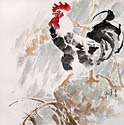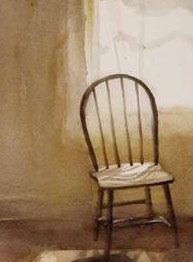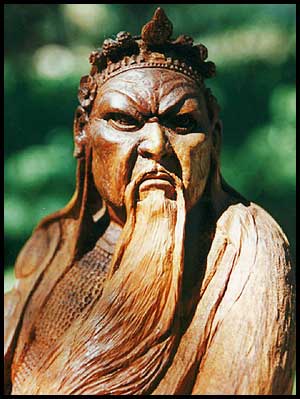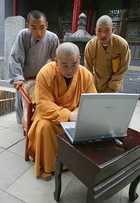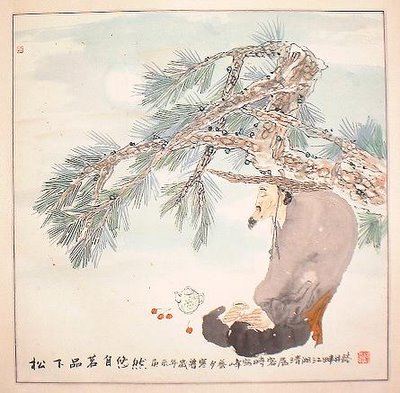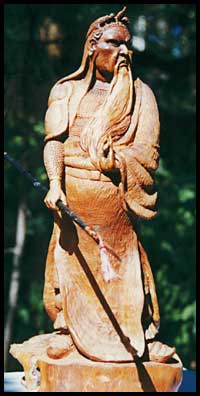Once of the topics I find most interesting in discussing martial arts training, or really in any aspect of life is the mistakes we make. What follows is a collection of posts from various martial arts forums that have to do with making mistakes in training, interspersed by some commentary and observations.
Some of this stuff is six or seven years old. I apoligize for not being able to given proper credit to who said what. This is pretty long, but I hope you find it informative.
==================================================
Mistakes
Best Practices - Martial Arts top 12 classic training and performance mistakes.
-----------------------------------------------------------------------------------------------------------
* Undermined motivation.
* Uncontrolled problem classmates.
* Noisy, crowded training room and sessions.
* Abandoning the training goal planning under pressure.
Students make plans and then routinely abandon them (without replanning) when they run into training trouble Without a coherent plan, the students projects tend to fall into a chaotic train -and-fix mode, which is probably the least effective development approach for all but the smallest training goals.
* Shortchanging upstream activities.
Students that are in a hurry try to cut out nonessential training activities, and since long-term training exercises don't directly produce quick results. They are easy targets for the training decision ax.
* Shortchanging quality of training to improve the quality of the performance speed.
* Lack of performance control.
Students have a tendency to try to do everything at one time.
* Silver-bullet syndrome.
Silver-bullet syndrome occurs whenever students expect any single new training tool or methodology to solve all its training productivity problems. Silver-bullet tools and methodologies damage the training of the students in two ways.
First, the new training tools or methodologies virtually never deliver improvements as dramatic as promised. Training-wide productivity improvements of more than 25 percent from first use of a new tool or methodology are virtually unheard of.
Second, belief in silver bullets leads to serialization of improvements that could be made in parallel. Because teachers or students put all their faith into a single silver bullet, they try promising new tools and methods one at a time rather two or more at a time, which slows the adoption of potentially beneficial new tools and methods other than the silver bullet.
The bottom line is that trainees that succumb to silver-bullet syndrome tend not to improve their productivity at all; indeed, they often go backwards
* Wasting time in smoke, flash, bells and whistles
* Insufficient establishment of what the student wants in their training session.
* Overly aggressive training schedules.
* Adding new teachers to a late training schedule.
CALL TO ACTION. This list of mistakes is hardly exhaustive. I have simply identified the mistakes I have seen most often. Your list might be different. A complete list would undoubtedly be pages longer.
Regardless of the exact contents, keep some list of classic mistakes in mind. Conduct training sessions post-mortems to identify the classic mistakes particular to your training.
Exchange war stories with fellow students in other organizations to learn about the mistakes they've made. Create checklists of mistakes for use in your training. Post lists of classic mistakes on your notebook for use in performance monitoring.
The classic mistakes' seductive allure brings them into play again and again, but we as an industry have gained enough experience to recognize them for what they are. Now that we recognize them, we just need to be hard-headed enough to resist their appeal.
///
Ok folks. I got to spend several hours with Mike Sigman quite recently so here's as brief summation of some (a lot of stuff's left out, but it's already too long for most to get through it) of the lessons I learned. Upfront, I'd like to say that I did some things right, and inadvertantly applied too much SPD (Self Perception Disorder) to some other aspects, but certainly got a lot out of it (much more than Mike Sigman did, IMO).
I merrily go back to the woodshed...
A NOTE ON SPD BEFORE WE GO ON
-----------------------------
- SPD isn't just complete defiant resistance to obvious truths such as "I'm not good at TAIJIQUAN coz I haven't done it for 20 years" - It frequently applies to not really being aware of what you're doing. -- You can know academically what to do and even have some ability in certain aspects of those things and continue to have SPD in other aspects --- "I'm not using my shoulders" (you are just using less than you did before), "I am using my waist" (you might be, but you're using more arms -- been there -- done that, will likely continue to do more)
- To get better you have to address your problem spots, but if you can't accept them, that will never happen. Because I trust Mike's eye, I welcomed the corrections though I think he might've been too diplomatic at times. Getting all huffy won't improve your internal strength.
WAIST, WAIST, WAIST
-------------------
- I understand the importance of the waist, but still underestimated how much I should move it -- "dive into it"
- Optimal training progression, esp. for LIMITED TIME hobbiests, requires more obvious motions at 1st, more so than many big dogs will be happy with, but we don't have 6-8 hours a day to train. legs, waist, hands a good breakdown
- I had improperly copied CHEN XIAO WANG by making my waist and store motions smaller. Via SPD thought I was doing similar to him.
- w/ CHEN XIAO WANG you won't see back store unless he chooses it, but the waist muscles still act as if back store was there.
- I stopped spear shaking coz I knew something was wrong - to address the perceived problem I went back a step to spear circling, but I did it **WRONG** -- SPD about my waist motion **IRONY**: my actual waist usage during issuing (my perceived problem) was not too bad, far better than my attempts at remedial circling - understood the windings in shaking better -- same as universal exercise, piquan, rdfo, etc. DUH!!!
- better idea of how principle 1 and princinple 2 are one, ex. "dantian rotation? There's just store and release to me."
IMPORTANT NOTE TO THE READERS:
- most folks do not have an idea what using waist is. Waist does not = hips, so if you can't move waist independantly of hips, not using waist.
- CHEN XIAO WANG's dantian moves like a rifle bolt -- he should teach seminars in a t shirt so folks can see how much waist a big dog uses. Back and hip motion can be minimal but his waist will move a number of inches, but the silk "dantian hiding" TAIJIQUAN outfits the big dogs wear frequently hide this.
BRACING
-------
- I did it in push hands, but I didn't know it --SPD
CAUSE: Easy to fall into coz it works, seems like it
is path -- SPD and I almost never push hands, and
usually w/folks I've taught the pattern to.
SOLUTION: Stand higher, never go into bow/bow+arrow/forward stance which begs to be braced
IMPORTANT NOTE TO THE READERS:
- chances are high that w/o a guy who 1) knows what it is and how it differs from path and 2) will monitor and correct you, you will likely brace too -- it's so easy to do. Accept it, find when you do it and fix it.
SURPRISE, SURPRISE
------------------
- hadn't worked on bounce jin in a long time. Apparently I could do it ok, "not bad"
- saw it's usefulness (and short power in general) w/in push hands
- finally getting a physical grip on double bounce jin (knew academically for years but couldn't translate it to body), the change point is probably that I can actually do bounce jin to some effect and when I first learned it, I could not. Can't do double before single.
MORE SPD
--------
I watched as he taught (of course it was supposed to be show and tell, but as I expected all along it basically became a 2 hour lesson) some TAIJIQUAN enthusiasts. Observations of some SPD that may hinder their progress:
- had no idea they had no IS basics, even after shown some stuff
and not really being able to do it right/very easily
- convinced they practiced right coz it matched the words, ex:
"We practice right outside of competitive push hands, How do I get the IS to come out during push hands?"
Mike, learning CHEN XIAO WANG type diplomacy, let them know gently that if they did practice right, it would be there, but that was probably too gentle to effect any change.
- matching the classics to what they do "the reason my arms are bent so much and thus bad for conveying path is because I spend so much time sinking the elbows."
- unaware that results will let you know if you have done correct practice. Mike told how he used to do Yang style long form at least 9 times a day (that's a LONG time), as well a the other forms, looked smooth, etc., but came to the conclusion that despite all that diligent training he one day realized he had done it all wrong and had to start from scratch. One of the guys asked how he knew his practice wrongly, missing the obvious answer -- no results.
- This is a good time to ask yourself a question, if Mike could practice diligently a beautiful looking form for at least 3 hours a day and still be getting no where, it it remotely possible that you might suffer minutely from similar? It is possible to get the foot in the door, then not go far.
The below are delivered in Mystery Science Theater 2000 style sarcasm mode as thoughts they must've been thinking at the time -- based on what did and said. No names, dates, or styles have been mentioned to protect the innocent (no point in naming names, just good examples). No animals were harmed in the production of this email, either.
- the goal of TAIJIQUAN push hands for some folks is a game about balance. Positions that avoid falling, but have no possibility of power or issuing are good (and boy one guy amazed me with his ability to stay vertical).
- Because the push hands game is about balance and and not using tension so letting a guy who has the ability to do short power (which isn't in our style.) put his elbow on my chest, or shoulder on my chin is acceptable.
- positions that would let my arm get broken in a confrontation but do not disturb my balance are acceptable in push hands
- I cannot be locked, that my partner is being civil has no bearing in the matter. Tapping is for wimps.
- "we do that" (they didn't)
- "we sort of do that" (they didn't)
- "that different in our style" ("There's only one TAIJIQUAN" Yang ChengFu)
- winning in push hands are indicators of good TAIJIQUAN
- proper TAIJIQUAN is invinceable, so realistic assessments of IS skills not applicable in the push hands environ because TAIJIQUAN defeats experience and tactics 10 times out of 10.
- loyalty to style is paramount, "I'm a XYZ stylist so could I see how I fit in", "Elbow, shoulder, lie are not done in our style, if they were, we'd be good at it too.
============================
Subj: neijia: There will be ground rules for Boston practice group
Date: 4/4/00 10:45:16 PM Eastern Daylight Time
From: ras@MIT.EDU (Richard A Shandross)
Sender: owner-neijia@lists.Stanford.EDU
To: neijia@lists.stanford.edu
I've been thinking about the lack of success of my first attempt at having a neijia practice group about 5 years ago, and what would be best for the current try.
Five years ago we met, would spend about 20 minutes total repeating random exercises from the workshop, and many more minutes talking. It was chaotic, folks didn't know where to take things, and interest petered out quickly.
This time I'm going to do things differently, since now I've made enough mistakes that I know how to avoid a few of them.
I am definitely NOT going to play the role of teacher, but I AM going to structure the practice groups to ensure that we be properly focussed, disciplined, and don't waste people's time. I think there will be room for minor modifications and evolution of the structure, but this is basically how I want it to go, and I'm the one organizing the thing, so nah nah nah nah. :-)
GROUND RULES:
1. The goal of the group will be to work on the four directions of power, storing and releasing, and opening and closing.
2. The basic warmups and exercises will be done in the order given below, and we won't skip steps. That is, we will attempt to achieve the purpose of each practice before moving on to the next.
3. No one is the teacher; we should all give each other feedback and frequently seek feedback.
4. There should be a minimum of intellectualizing. This group is to be about DOING IT, not talking about it.
5. We will not deal with forms, weapons, philosophies, etc. unless and until we successfully finish the basic warmups and exercises.
PRACTICES:
1. Establish four directions of power with groundpath.
2. Working the four directions, with groundpath, in standing (ZHANZHUANG) and SILK REELING.
3. Back bow (storing and releasing (nonexplosively)).
4. Moving while keeping the groundpath. Pushing from the waist/spine.
5. Opening and closing (universal exercise or similar).
6. Once we get to this point, we can play with push hands, simple applications, FAJIN, whatever, if there's time and inclination.
OK folks, let's get some skills!!!
Rich Shandross
==================================
> I'll let you know - it might be a while, though. I've got to work this stuff into my CHENG MAN CHING form, my Chen form and my CHENG MAN CHING sword >form... not to mention push-hands and then sparring.
>
Well, if you try to do this, you will probably have wasted a lot of time and money.
I'd suggest that you stop doing the CHENG MAN CHING form entirely (as in, never, ever do it again). Everything the CHENG MAN CHING form contains, and far more, is contained within the Chen Yi Lu. Don't do the Chen form for something like a year either, except for once a week or so to remind yourself of the choreography, and hang your sword up until you are comfortable with the empty handed form. If you have the neijin, learning the forms again is icing on the cake, if you don't have the neijin, those forms are worthless, and they will only distract you from what is really important. Those forms aren't going anywhere - and neither will you if you hold onto them.
In my experience, the biggest reason that people go to seminars, think they learn something, and then still fail to improve is that they attach some value to the forms they know already, and refuse to let them go. I'm saying this based on my own experience, as well as seeing other people make the same mistake, over and over again.
My advice is to cut your losses - forego forms practice, except for maybe 1 form, that you only do to keep from forgetting it, and spend all your time doing basics: standing, single movement exercises, line drills and 2 man work (like push hands). Holding onto those forms will only retard your progress. Especially if you are holding onto a form that was probably taught to you incorrectly, or which doesn't lend itself to learning basics.
If you are really diligent, maybe in a year's time, you'll be able to do all 8 TAIJIQUAN jins consistenty and reasonably correctly in single exercise drills. Which is actually kind of ambitious, if you ask me.
Stephen
===============================================
If it was me, I'd simply open doors, close doors, lift iced tea, flush the toilet, etc., etc., with the correct strength. Try to do *everything* that way for a few months. You'll get miles ahead. Forget forms for a while. Do simple 4-power circling, etc. My opinion, FWIW
Mike Sigman
=============================================
>
>>I'll let you know - it might be a while, though. I've got to work this
>>stuff into my CHENG MAN CHING form, my Chen form and my CHENG MAN CHING sword form...
>
>Uh, why? I think you need to get a better handle on where the
>practice of forms fits into your training and overall objectives. If one
>form is good enough for Yang Lucan, Chen Fake, et al. Why do you think
> you need to do CHENG MAN CHING and Chen?
Actually, I never thought about it - I just kept practicing what I was taught for lack of any particular reason not to. :-)
Now that both you and Stephen Chan have challenged that assumption of mine - made me look at it - I think you're both right. I don't need multiple forms; I certainly don't need multiple arts, either. And since I have to work for a living (like most of us), I have a very limited time to spend on any practice, so I should focus it instead of "spreading it out".
If I had applied my professional judgement to my personal practice, I would have realized that on my own.
Thanks for your opinion and willingness to point that out.
Best regards,
Jim "Same amount of roadwork, but only in one direction" Mercer
> I suppose teachers are able to recognise and correct mistakes of their
> students, because the teachers made those very same mistakes themselves.
>
>
> What are some of the dead ends, false starts, and red herrings that you
> encountered?
>
Ok. In typical fashion, I ended up explaining quite a bit, so I'll sum this up since it's standard to be ignored if you write more than 1 page of stuff unless you focus on an inflammatory task involving personalities or other religion topics. SO let me sum up the points.
Those who feel it useful, please read the explanations below. If you come away with anything I hope it's this. "If you're not getting any better at the things you're supposed to be getting better wrt IS" some reasons may be in the points below.
1) the bottom line
2) not emptying one's cup
3) not being goal oriented
4) picking ego over "the bottom line."
5) honesty with one's self
6) Not seeing the big picture/understanding things shallowly.
7) You're always cheating!
1) the bottom line: What can you do? Talk, email, buzzwords don't mean a thing if you can do anything. In truth, if you're really on the right track you can do things, and the time scale should not be measured in years. Don't ignore the bottom line as a reality check. BTW, if IS is what you're after (and folks do indeed do IMA for reasons otherwise), the bottom line is not, "pretty choreography," or "generally feeling good."
2) not emptying one's cup: Took me ~ 2.5 years to go from "hey! We do basically that" to the realization "I've got to dump it all or it will hold me back." People hate to hear this and usually delude themselves into thinking they have emptied their cups or that they understand things, or the way they were doing it was compatible. See the "the bottom line," if you've emptied the cup and are doing things right, you should be making progress towards tangible (i.e. verifiable by *impartial* observers, i.e not solely your own good feelings). Makes me sound mean to some folks, but since I gain nothing (fame, monetary value, popularity all seem to, in fact, decrease when this is said) you have to realize I'm just trying to someone else some time of spinning one's wheels.
3) not being goal oriented: A man w/no goal, "goes nowhere quickly" Most folks collect buzzwords and exercises and frequently "the secrets" but don't really know what their trying to achieve. Be it, IS, fearsome fighting ability, health, whatever, if you don't organize your efforts towards that and just do a mish mash of stuff with no order, you too will "go nowhere quickly" -- which may be what some folks are looking for.
4) picking ego over "the bottom line." Everyone has an ego, but some are aware of how they try to protect it and others are totally unaware that the real reason they do stuff (in this case, IMA) is to bolster their ego. A teacher that *REALLY* wants a student to learn, will take the time, to correct, to hands on prevent folks from doing things incorrectly. If a student is consequently screwing up, it's a real teacher's **DUTY** to not let them continue. If the student is serious about progressing (have a goal, pay attention to the bottom line), a 5 minute ego crush is worth the time saved doing it right. I know a lot of times folks may spare some corrections coz some folks cannot take criticism and just intentionally get upset over correction, but for me personally I don't want to be wasting my time. Just had Mike S over this weekend and I'm glad he likes me enough to actually tell me when I'm screwing up so I have the chance to try to adjust it, rather than happily going about my way doing it INCORRECTLY.
5) honesty with one's self: Related to 1,2, 4. If you can't do it, you don't really know it. When you first figure out something, naturally you're not too good at it. But if it stays pretty much at a low level over a period of time (say a year or more) then you don't really understand it coz you really haven't been practicing it correctly. This applies to so many things, "we use the waist" (if it can't move in dependant of the hips, you don't) "I'm using jin/path", (if there is not a direct correlation with the waist, you aren't", "I'm not stiff" (it's relative, you might be less stiff than before, but chances are high you're still stiffer than optimal. Another checkpoint is that if you can keep a non wavering groundpath and move the joints, you are too stiff), "I do good push hands" (if winning is priority #1 you aren't. If you loose balance (which you may not recognize) but change your balance loss into a grab on tight, swing him around with momementum so he steps a bigger step than you, or re adjust your feet without acknowledging it until you turn around the situation to something that was lost to a winning position, you're winning the game, but not training good skills).
"It's so hard to change/learn" (how hard have you really tried, did you you empty the cup and start from scratch? Do you refuse to accept that whatever sentimental reasons or legendary exploits of your teacher and lineage, if they don't use jin all the time and you can't do anything wrt jin after say 2+ years (the bottom line again) that what they probably was external.
This is also the not me, "Oh yeah, all those guys are not internal, except you and ME" Or "Those guys are all bogus, thank god, my teacher is is legit.
6) Not seeing the big picture/understanding things shallowly. THis relates to much of the above point.
- Most folks think knowing the buzzwords is knowledge
-- apply "bottom line" if you can't do it, you don't know it.
- In the big picture there is a progression of skills, if you know the path you can train along it
-- goal oriented
- Thinking feeling path in the foot, or not being pushed over, or winning the game known as "he who steps first, or bigger loses" aka fixed step push hands, means you know the whole deal
- Thinking when told directly by oftentimes more than 1 person that you suffer any of the following: too stiff, use too much upper body, "use the waist more", "that's mostly arm" doesn't apply to you coz your understanding is much better
- ignoring the fact the dantian doesn't move independantly of the hips, that after 3+ years, the teacher test is still as inaccessible as ever, etc.
7) Corrallary to above: You're always cheating! As you get better, you may cheat less. The ego learns to hide your own cheating from yourself, sometimes this is by just being oblivious, other times, it's using non internal methods that have similar response (like a fast, hard, loud, strong shaking fajin that does use some waist, but is really 80% upper body -- those of you who fajin more impressively than Chen ZhengLei should consider this, coz chances are 100% that the kind of torque he can inflict on a long spear exceeds what you can do by a many folds despite that your hidden hand punch looks and sounds more impressive than his after 45 years of training). CHEN XIAO WANG tells me he still works on perfecting stuff, i.e. ridding himself of cheating, so unless you do it better than him you are cheating.
This attitude can make your training more effective. Think of it as a game, you body cleverly finds ways to cheat, your mission, should you choose to accept it Mr. Phelps, is to find those cheats as efficiently as possible and get on the track of training with results.
Fo
=====
> section 5. see below seems particularly applicable to me and it makes me
> question if what I've been doing for 3 years is really TAIJIQUAN, and where the system breaks down. is >it my training that isn't getting some things across, or is it the system or the teacher?
what Mike said...
> The simplest and most obvious obsercation about myself, and anyone who worked with me this >weekend will easily have seen that my upper body still comes heavily into play.
Try less hard.
Part of point #6 (Not seeing the big picture) is focussing on the wrong results. With IS it's quality over quanity -- not how much you do, but how you do it. In fact that's what the teacher test is about, do you use jin and waist. Doesn't matter that you can put a hole in the guy's chest if it's from shoulder. Anyways, with the quality will come the quality.
Typically people over focus on 1 aspect to point of messing up or ignoring the other stuff. Examples:
- Feeling in the foot is the sole means I'm doing it
- winning push hands means I use IS
- impressive looking and sounding fajin is really it, even though the waist does almost nothing
- tense or tired shoulders can be ignored in favor of some other results
- etc.
If the upper body comes into play. Back off and do it with less resistance.
> Sure I can feel the waist in there, and when I relax my shoulders I can almost feel the waist fall into place. sometimes I >really got that feeling of my leg and waist really running the situation, but other times, I would really feel my shoulder
#6 again, getting a basic idea doesn't mean you have it. But many folks don't even get the foot in the door, much less step through.
> start to tremble ... I would try to justify that with maintaining the geometry of the shoulders to transfer force, but I must be >using some shoulder strength at some level to get things to work.
Don't. Go back and do it with less.
>
> Well, I noticed that there are some body positions in which you use less and less strength in >the shoulders. If I keep my arms wider fom my shoulders then I usually do, I can tend to get a >better line. Is this degenerating into a bracing situation of the upper body against the waist >which is maintaining a ground path, and is that TAIJIQUAN? I don't know.
THere are better and worse positions. It's why TAIJIQUAN is sometimes called the science of angles. It's also why some MA can never be internal because the shapes/structure do not propagate neijin well -- which is not to say they do not propagate power or are effective, just that they support neijin well.
>
> can anyone give some suggestions or thoughts as to how one does "loosen" the shoulders >enough that you can start to make progress towaard more regularly connecing the waist without >the interplay of shoulders?
Step 1. Be aware that you do it
Step 2. Constantly monitor it
Step 3. Practice, backing off when you notice shoulder usage
Step 4. Don't forget step 1, goto step 2
>
> Now, on to the more complicated and less understood things:
> This whole idea of moving the waist independently of the hips. I've never ever seen that before. I've seen people talk about it, >but it wasn't like what I'd imagined. My TAIJIQUAN system has never demonstrated the side to side movement of the waist.
Draw your own conclusions.
> I think there is some movement of the waist without hips in the sense of deep storing and >releasing, moving the dantien >forward and backward, but there is always physical up and down movementof the hips.
Are you sure?
> What are the implications of this sort of body movement toward developing decent IS? anyone?
Real usage of the waist means you should be able to move side to side w/o turning the hips much, and move up and down without bending/extending the legs, and then convey path to hands.
Naturally this will be limited in range, but not as much as most folks who don't use the waist think. If you HAVE to move the hips for side to side and/or HAVE to bend/unbend the knees to facillitate up and down for movements more than 1 inch, then you're missing it and will likely never develop it -- can't train what you don't do. IT's like expecting one's breast stroke to get better when I on do back stroke.
> One thing I coulden't quite grasp this weekend was whether I'm going in the right direction at all. There were obviously plenty >of folks with way more experience then myself, and I hope that with sheer hours of training I would get there....
> the question is whether I"m moving in the right direction and how to know
Work the basics, try to find the ways you're cheating. Stop cheating. Get qualified feedback whenever you can.
> that. I feel that I've improved dramatically from where I was this time last year, but I don't know if that is in an IMA way or not.
What criteria did you use? "Better" as catch all term for feeling better doesn't mean much. What is your goal? WHich aspects improved that brought you closer to your goal? DO any of these aspects have anything to do with IS. If no, you know the answer.
========
mike and others...
just wanted to drop my own two cents worth from what i teach in psychology. other psychology people on the list feel free to jump in and correct any errors i might make.
i doubt that you will end up changing the majority of players/practitioners that you are discussing for the following psychological reasons:
1. confirmation bias. this basically says that people will only look for information that already confirms the beliefs that they have. they will tend to not look for, or worse yet, discount/disparage/ignore information that would call into question their beliefs.
2. related to this, people tend to remember information that supports their beliefs, and tend to forget (i.e., not encode into memory) information that goes against their beliefs.
3. belief perseverance. this is one of my favorite psychological effects. even when you SHOW people evidence that their beliefs are wrong (even at the level of undeniable proof, not just when it is others' opinions), many people will STILL ignore the info and keep their beliefs. they somehow do a cognitive twist in their mind which allows them to keep the belief they have. as we've seen on the list, this usually consists of ignoring the info, trying to argue why the info is wrong, or disparaging the messenger.
quick example. belief: clinton is a scumbag.
confirmation bias would suggest that you would only read books, watch shows, have discussions with people who also think clinton is a scumbag. this narrows your world view so that you might never hear about anything he did that was actually good. if you did hear something bad, you'll remember it and tell others. if you hear something good about him, you'll promptly forget it.
belief perseverance. even if the courts find him innocent and he did 10,000 good things, he's still a scumbag.
it would seem that TAIJIQUAN has a large number of people who will have discussions that confirm their beliefs and will show belief perseverance even when it's apparent to others their beliefs are incorrect.
btw, it's very hard to fix/control/change either of these phenomenons.
so, i think that you have to do something else other than trying to change those people.
1. inform others as much as possible about these people and why they should be avoided. i'm not sure if there is a nice way to do that, without getting a whole lot of people who want bad things done to you.
2. keep doing what's been done to inform others thru methods like the neijia list, internal martial arts journal, etc.
but bottom line, i don't think those people will probably change their beliefs just cuz you or others point out the errors of their ways.
regards,
dan rozanas
------------
From: "mike cherrill"
> What do you regard as the key points of training, particularly for > beginners?
Probably the biggest distraction for beginners is "learning a form". Usually, in the West, a beginner learns a choreography from someone who is not really that good at TAIJIQUAN himself/herself and so they go off on the 'forms' route. I would suggest just learning peng, lu, ji, an and practice doing very slow, correct movements with them would be far more productive. Depends though on if you are trying to learn TAIJIQUAN skills or learn a choreography that will get your social life moving. :^)
> What exercises have you found to produce the best results?
Every door that you push open, push with very relaxed but solid ground path powered by the legs and back; no shoulders or arms. Every door you pull open, pull it open as though you are doing it with your belt and your front leg.
> What do you regard as the most dangerous pitfalls?
Getting wrapped up in a myriad details that your common sense tells you "wait a minute... that's not really going to work for any practical reason that I can see". The "blind faith following" approach sure to lead nowhere.
> Do you have any other comment that you would like to make? >
> Any help is much appreciated and will be useful to me and any other > newcomers.
Read as many books as you can that have *fucntional* information in them. Since there are almost none of those, simply read enough to get an overall idea of what the real major subjects are in TAIJIQUAN... then start asking someone who knows about those subjects (perhaps Yang Zhen Duo, CHEN XIAO WANG, Wang Pei Sheng, etc.)
FWIW
Regards
Mike
===========================
Roy K's comment about the shoulder's relationship to "pushing from the middle across the gap" are worth talking about...particularly in light of his comments about the shoulder locking up.
Point 1: "relaxation" versus lockup:
First of all, the idea of "groundpath", as I noted in an earlier post, is important... but for many people it has now become a simple "alignment" issue. That's not what it is. I'm seeing more and more people who "do peng jin", but they're basically using body alignment, "rooting", and a lot of shoulder and arm when the going gets tough.
A real problem with the "alignment" is that often what "relaxation" you get is simply from the fact that if you practice something hard enough and with enough resistance, you can wind up doing it "relaxed". However, this is like saying that a weight-lifter can slap you across the room in a "relaxed" fashion simply because he has worked out to the point where he puts little comparative effort into many tasks. For many years I've always considered this factor in both "correct" and "incorrect" jin paths... it has to be factored in that both ways of doing jin can involve a certain additional aspect of "relaxation" simply due to having trained extensively.
Another factor of relaxation in the "jumping the gap" problem is that (as Rich Shandross noted), some relaxation is obtained by the fact that the shoulder muscles are used to hold the structural position, but they are not driving the movement themselves.
Lastly (in point 1), but most importantly, let me get back to what I have said in previous posts. The idea of "forming a groundpath" involves recruiting *many* small muscles to handle a load on a "global" scale, as opposed to the local use of large muscles. Applying "downpower" involves the same sort of recruitment. An extensive training, while being very relaxed and using the mind "intent" (all of this in order to shift away from the way we've trained to move since being a baby) is needed to recruit all of these small muscle contributions. I like to use the example of someone applying shao tran (nikkyo) to my wrist and stopping it with a relaxed application of jin.... there is no tension when I do this, yet the joint does not collapse.... think of the global recruitment of muscles that is needed to effect this "trick" (but a martially usable trick, at that).
My point is that if you have areas that are "locking up", you need to go back to basics. If you are going to be "relaxed, but strong as steel" (i.e., the "needle in the cotton"), you must train from basics, not from "alignment".
Point 2: a method of gaining control of some things:
I'm not sure how to describe this, so please be lenient in the critiques. :^)))
If you are holding a staff point straight out from your body, you can bring the end of the groundpath to the end of the staff. You "bring your qi" to the end of the staff. Forming any groundpath involves bringing something (the end of a resultant?) to a particular area. In this sense you "grab control" of some part of your body or a weapon.
If you bring the focus of your weight to your armpits or your elbows, or your hands, or to the edge of a down-cutting sword, you are likewise "bringing your qi" to those areas. Downpower, like "groundpath" (both of these are properly part of the same phenomenon in "peng jin") involves recruitment of numerous global muscles to "grab control" of some part of your body or weapon.
I could extend this idea to throwing a baseball. I "grab control" (i.e., I "bring qi") of the baseball when I throw it. Imbuing the baseball with this form of control results in some marked results. As a matter of fact, you can "grab control" of the end of a golf club and use it to hit a golfball in the same manner. Koichi Tohei, of Aikido fame, used to teach this sort of trick to golfers... using your "ki" to hit a golfball. A few years back, I laughed when I saw that some smart westerners had begun selling a practice golf club that was hinged on the shaft... the only way to hit the golfball with that club was to "grab control" or "bring your qi" (to a certain extent; there is a bit more in the details) of the business end of the golfclub.
The important thing about the golfclub is that you somehow "grab control" of the end of it.
The point I was getting to was that you can "grab control" of your arm and fist in the same way when you "launch" them with a punch... you don't use local motion to do it. You can strike with an elbow, a shoulder, a leg, etc., etc., in the same way. It's an adjunct that is important as your skills increase.
FWIW
Mike Sigman
...feelings are all our bodies give us to work with. I don't see a big problem with the "calibration" process either. You do something, you feel something, you get feedback by comments from a competent teacher - repeat ten thousand times and your "neural network"
*will* be able to quite precisely tune into a "correct" motion, even if you can't eloquently explain how it does that.
On the other hand simply embracing all kinds of feeling occuring during practice makes no sense. Not everything you feel will be helpful for your practice, the process of weeding out the unimportant or even detrimental feelings is what concerns us here. To do that most efficiently, we will certainly need a good teacher. But he will naturally judge us from *external* signs - he can't read your mind to find out what's happening *internally*, he can just watch and feel what your body is doing.
----- Original Message -----
From:
>>
> Are people being too ambitious, not ambitious enough? Are they
> focussing on the "right" things (whatever they are), or getting ahead > of themselves?
I think they don't do the part about defining their goals ... they just do a bunch of ritual stuff, hoping the rest will happen.
My private comment would be that in most cases of "extensive workouts" (like XXX's for example), even though someone may workout for 2.5 hours, their functional and productive workout is probably only about 15 minutes. They waste time on unproductive practice.
FWIW
Mike
I've had a couple of offline conversations going about "muscular push hands", "TAIJIQUAN fighting", etc., so I thought I'd throw out a couple of personal observations to get some discussion going.
The first thing I'd say about TAIJIQUAN is that the major thing I find of interest in it is the unusual strength. Finding out the components of that strength and developing it is what I am interested in. The "techniques" of TAIJIQUAN, the power of a XINGYIQUAN p'i-chuan strike, etc., etc., are all secondary to having developed that form of strength. Someone who has "learned a form" or been shown some "Tai Chee applications" or says that "judo is the same thing as TAIJIQUAN" ... these are all people who have missed the point. You
can't use the famous "shaking power" by just learning to mimic a shake.... you have to develop all the body skills and conditioning before you can do it actually and effectively. You can't learn a few "jin tricks" and think that you're there... and finding like-minded buddies who will support your
idea of "Tai Chi" by engaging in a safe-formatted bs competition called "push hands" won't make what you're doing real TAIJIQUAN, either. Basic skills and conditioning come first.
I always marveled at the people who would lean far backwards in push hands
and call it "neutralizing"... it was always one of those surreal things that made me question just how sane some of these "Tai Chee Teachers" are. Push hands techniques are steps toward sparring and fighting and any "trick" that would teach you to expose yourself to danger in a real fight is not part of real TAIJIQUAN push hands. For someone to lean over backwards, break any possible jin path, and expose their groin to any attack desirable to the
opponent... it's simple insanity. I remember listening to one of the tournament sponsors telling me about a conversation he and a number of skilled Chinese had with William C.C. Chen about that sort of thing... the opinion was universal (particularly among the Chinese big dogs) that this
little trick was a complete error and waste of time and it was disallowed in most of the tournaments.
So what would the opinion be on the list of someone who used a lot of muscle, showed off his "leaning back" evasion, etc.? If you "lost" to such a person, would it bother you? Are you worried about your jin skills or are you worried about "losing"?
There are a number of situations I encounter in push hands that are, to me,
similar to the "lean back" as obvious errors. I can't name all of them, but I can name a few that jump readily to mind:
1. Someone gets into a stance that leans forward like a wrestler. When you pull them slightly they tense to try to regain the balance they lost so easily and they jump toward you. How is that TAIJIQUAN? Yet, they are the sorts of people who will drone on and on about "central equilibrium".
2. Someone gets into a stance so that their head is inches from yours. I learned to never let this happen after a few pretty martial Chinese knocked my head with theirs. Never put your head anywhere in the neighborhood of the opponent's head or shoulder.... it's a basic mistake, even if the other person doesn't take advantage of it. If you "win", but that's one of your habits, then your "winning" is only artificial.
3. If someone likes to lean over, drop down low and come powering up at an angle to "push you" it usually means they haven't been trained enough to understand what Kao does to someone coming up. Many, many times I take an upcoming push like this without responding simply because I know the opponent has never been hit that hard and I don't want to be the one to
break the news to him. It's another basic error that I have learned to ignore while I'm pushing hands with a lot of people.
There are a number of other basic errors that people engage in, but you get the points. Most of what people do is not really TAIJIQUAN because they don't have the skills/conditioning to back up the use of "TAIJIQUAN" in what they're doing. A lot of the "push hands" is based around childish "Spanky and Our Gang" errors that have developed because of the low level of training that abounds. The thrust of what I'm saying is pointed toward getting people away from the "winning" against people who are making very basic mistakes but who can muscle you to a standstill. Focus on what TAIJIQUAN is and try to go in the right direction.
FWIW
Mike


